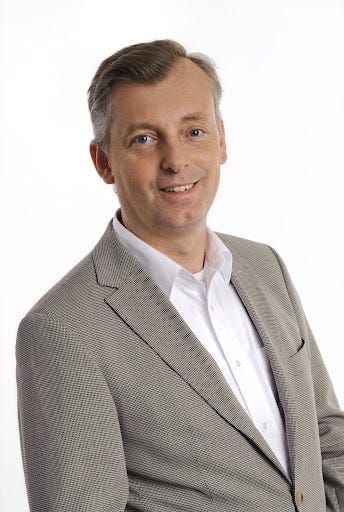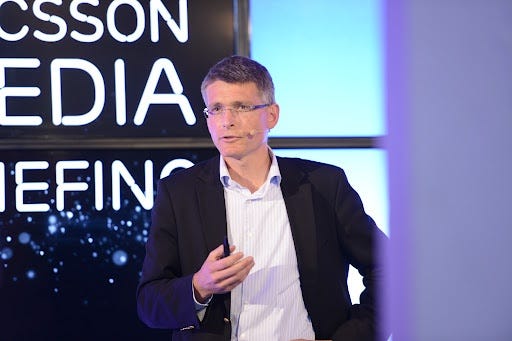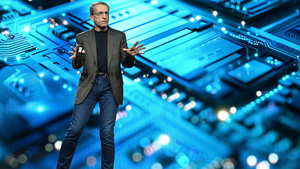Ericsson CTO Ulf Ewaldsson: A New View of Networks
In this extensive interview, Ericsson's new CTO gives his views on SPIT, customer experience metrics and those complex mobile signaling issues

Ulf Ewaldsson took over as Ericsson AB (Nasdaq: ERIC)'s CTO in February. A 22-year Ericsson veteran, he certainly comes with the experience for the job -- but unlike predecessor Håkan Eriksson, he'll be doing the work from Stockholm, not from Ericsson's Silicon Valley office. (See Ericsson Appoints New CTO and Analyst Acclaims New Ericsson CTO.)
So, when Ericsson brought several senior executives to San Francisco this week, to present results from the company's Traffic and Market Report, the highlight for many of the local press was the chance to meet Ewaldsson. He spent much of the day in different corners of the Terra Gallery -- an event space two blocks from the headquarters of UBM Technology, Light Reading's parent company -- conversing with one reporter after another.
We grilled him about Service Provider Information Technology (SPIT) -- topical, considering Ericsson had acquired Telcordia and had done away with the "Telcordia" name 24 hours earlier -- and about an interesting plan to build compute-drive cards that work across Ericsson's multiple, unrelated hardware platforms. (See Say Goodbye to Telcordia.)
Later, we were joined by Eric Ekudden, head of technology strategies, who had presented some interesting results about the signaling that goes on between mobile devices and the network. That's been an issue ever since it was discovered to be messing up smartphone sessions. (See Android Zaps Signaling Noise and NSN: Android & RIM Are Signaling Bad Boys .)
Page 2:The SPIT Era
Page 3:Mobile's Mixed Signals
Page 4:Redback's Smarts
— Craig Matsumoto, Managing Editor, Light Reading
Light Reading: Operators have so much change going on. Is their role even the same as it was?
Ewaldsson: We say that the operators are becoming more different. If you go back in time, the operators were more homogeneous. They more or less offered the same voice services.
With the introduction of mobile data into the networks, we see different strategies being pursued. We see some operators going down the connectivity play only, becoming more of a utility provider. We also see segmented tariffs on data [i.e., tiered pricing]. But we also see some operators going all the way, wanting to be providers of media.
For us, it means more business opportunities, because we can start to do more different things -- segmentation to different operators with different strategies.
Light Reading: And that expands your role into areas like analytics and data-gathering.
Ewaldsson: That's right -- some sort of simplification layer on the networks. The networks get extensively complex, with all the data usage, and we have to factor it all down to actual user experience.Most operators are asking us, Can I measure why 5 percent of my users feel like this? How many YouTube sessions are dropped? How many are stopping the session before the end of the clip?
That requires, then, a pretty heavy piece of analytics to be able to do that, and also it requires an OSS/BSS system that can gather all this data. Thus, last summer we announced that we intended to buy Telcordia in the U.S., which we did.
We're also going through a lot of modularization of our own software and also other people's software, so we can put that on top of the system, building more or less an open architecture for the operators.
If we don't do that, the operators will not be able to follow everything that is happening. There are other companies that are working on technology that is very interesting, startups that are working on technology that could be very useful -- if we are not able to incorporate those technologies faster, that means we will not be able to follow a very fast-moving industry. So we're sort of cloud-ifying the way our products look, and we can address this with one architecture.
Light Reading: That would be very interesting. I've heard other companies, like Juniper, talk about the possibility of running other people's software on a router.
Ewaldsson: That's right. Juniper has a strategy that's not so dissimilar. But they are in the routing space only. They are actually a company we are working with as well.
The future of the network is nowhere near the way these networks were built in the past. You're going to have to have much more distributed intelligence in the network, so maybe in this building we're sitting in now, you may have caching functionality, particularly clever networking, as well as a heterogeneous radio network with lots of radio spots in different spaces. And that might be only for this block. In the old telecom paradigm, you would have to build one megacenter in San Francisco where you would have all the intelligence. Now the core network can be distributed.
Light Reading: The gear would have to change too, I'd imagine. It's a more software-driven world.
Ewaldsson: I think there will be more frequent software releases. We have, during the last year, sped up our way to do software. Today we have one major release of each of our systems -- on the radio side, for instance, wideband CDMA, LTE, GSM, CDMA, whatever -- we have that every half-year, with updates in between. That's when we release a lot of features. One of the reasons is the quick changes in smartphones. We need to keep up.
We're also timing these releases with the release of new phone products, not from ourselves, but from the ecosystem. A lot of this is standardized in 3GPP, so there are a number of power-saving features and so on that the phone manufacturers really would like to use, but it doesn't make sense unless it's supported on the network.
To Page 3 Erik Ekudden joins the conversation. He was one of several executives presenting on different aspects of Ericsson -- the Silicon Valley operation, in his case. He'd breezed through an anecdote about how, in December, Ericsson had hosted some application developers to an event, opening up the network gear for experiments. One such experiment examined how mobile-device signaling affected battery life during video downloads -- and we'd asked if he could elaborate on that.
Erik Ekudden joins the conversation. He was one of several executives presenting on different aspects of Ericsson -- the Silicon Valley operation, in his case. He'd breezed through an anecdote about how, in December, Ericsson had hosted some application developers to an event, opening up the network gear for experiments. One such experiment examined how mobile-device signaling affected battery life during video downloads -- and we'd asked if he could elaborate on that.
Light Reading: So, the signaling experiment you mentioned -- what was that about?
Erik Ekudden: This was one device and two video download applications...
Ewaldsson: It was YouTube.
Ekudden: Well, they were both YouTube, but it was different ways of handling the media streaming. So in the first slide, the device downloaded at a relatively low but constant speed. That was very efficient from a signaling perspective, but it was very inefficient from a data perspective because it used only a fraction of the bandwidth. It was trickling along, and when it was done, we shut down the stream.
The other media player actually chopped the clip up in shorter segments and sent them at higher speeds. So, if the channel had 20Mbit/s, you used 20Mbit/s -- you didn't download at 1Mbit/s. But then it had too much signaling.
So what we came up with in that workshop was a compromise. If they could get 70 percent better battery life by sending packets, yes, so you should chop it up into different sequences, but then shut down afterwards, so you spend less data and less signaling. So, there was a very good finding for that application developer and that video application.
Ewaldsson: This is an art form. We can even base the chopping-up on statistics -- how long people are watching. There are so many things that you could do once you start down the path of optimizing how the network is handling things.
Light Reading: Do you know if any of them did anything with this finding?
Ewaldsson: They all did.
Ekudden: Absolutely everyone did. These application developers -- this is what they live for. They have to create a competitive advantage through a great user experience. If you consume 70 percent less battery, for sure you're going to win if you have competitors that don't.
Ewaldsson: Even social sites, some very famous, have made adjustments. They adjusted the code to fit better to a mobile environment, and we helped them to do that.
To Page 4
Light Reading: We've talked about software, but how about the hardware side? How is it changing to fit mobile data usage?
Ewaldsson: We made a bet a few years ago that routers would have to be a little bit more intelligent than they were in the past. Edge routing has already gone through that move because the edge was able to gather information on subscribers and what they were using.
This is a mobile router that is connected to the intelligence that the mobile access system provides. The mobile access system knows everything about the subscribers -- who they are and what they are doing -- and if you connect that to the SSR [Redback's router], you can shuffle your IP bits much more cleverly in relation to where there is radio capacity or what can be done in the radio net.
Cards in the middle of the router that are handling the intelligence of how the routing capability should be distributed -- those same cards can be put into the base station or put into other places. We can move both the hardware modules and the software modules around. The software module that's running on that card can also run on a radio controller or another piece of the network. This is new. That's something we refer to as the virtualization of our own gear.
Light Reading: But didn't your hardware come from different places? The router was Redback, the base stations are Ericsson...
Ewaldsson: Yeah. We can put in other people's software on top of the operating layer that we have. And the same thing goes with hardware. We can take a new piece of hardware that we have and run any piece of software on it that we have in our portfolio.
Light Reading: How big a project was that?
Ewaldsson: It's in the making. For the router, it's done. Then we're gradually doing this more and more.
Already today we have something called the Ericsson Blade Server which is an all-purpose machine. So we run the radio network controller on the Ericsson Blade Server, or we can run the IMS node on it -- they do totally different things in the network.One of the cards in there is actually the same card we can use to control the router. I think overall, this is a strategy we are going to pursue.
About the Author(s)
You May Also Like











